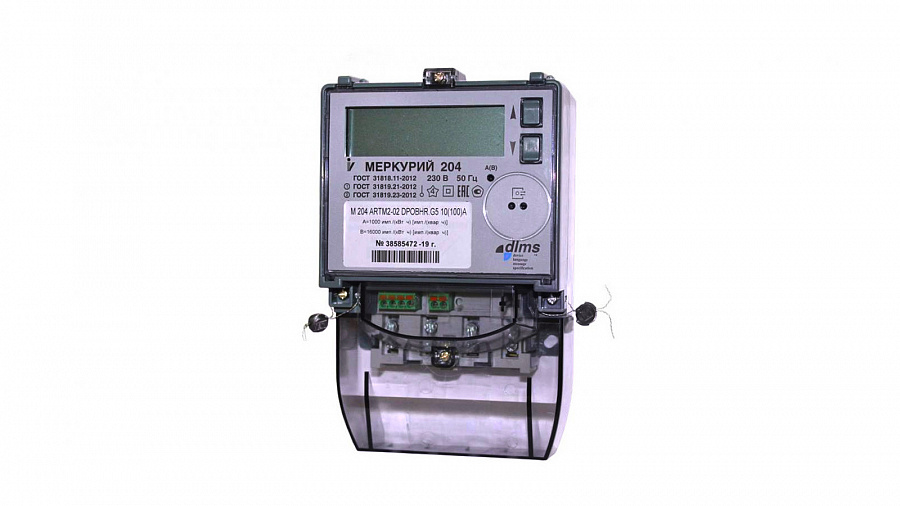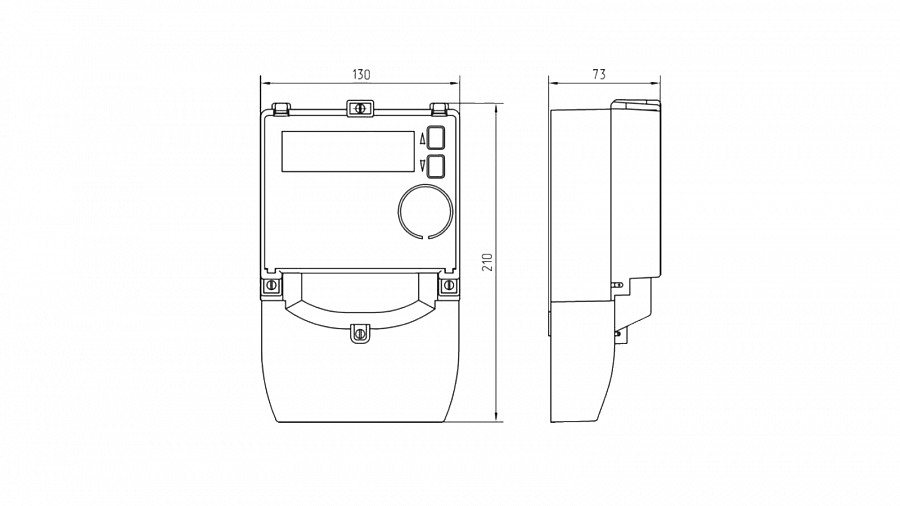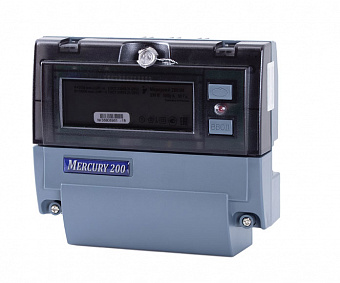
Mercury 204
APPLICATION
The meters are designed for uni- and bidirectional multi-tariff measurement of active and reactive electric energy and power, as well as electrical parameters in two-wired AC networks with subsequent accumulated data storage, generation of events and data transfer to the AMR/AMI system’s data collection centers.
The meters are designed for indoor operation and can be installed in the areas with additional environmental protection (installed inside premises, cabinets or boards).
MODIFICATIONS
The meter modifications are available with different rated and peak current, and additional functionalities which are not related to metrological perfomance.
Metrological performance
| Meter accuracy class (active/reactive) |
1/2 |
| Rated voltage, V |
230 |
| Base/peak current, A |
5/60; 5/80; 5/100; 10/100 |
| Peak current during 10 | 30*I max |
| Starting current, А |
|
| • for meters with base current 5 А | 0.02 |
| • for meters with base current 10 А | 0.04 |
REGULATORY COMPLIANCE
GOST R 52320-2005, GOST R 52322-2005.
| Active/total power consumption in meter voltage circuit at rated voltage, W/V*A | 2 / 10 |
| Total power consumed by each current circuit, max, V*А | 0.1 |
| Additional active/total power consumption in meter voltage circuit at rated voltage if PLC interface is available, W/V*А | 2/24 |
| Additional active/total power consumption in meter voltage circuit at rated voltage if GSM interface is available, W/V*А | 4/5 |
| Number of tariffs | 4 |
| Data retention during power outage, min, years | 10 |
| Calibration interval, years | 16 |
| Warranty period, years | 3 |
| Mean time between failures, min, h | 220,000 |
| Operating temperature range, °C | -45 to +70 |
| Weight, max, kg | 0.95 |
| Dimensions (LхWхH), mm | 130x73x210 |
— The meter measures, stores, displaying on LCD and communicate information via different interfaces of active and reactive electrical energy independently by every tariff zone and cumulatively for all tariff zones for the following periods of time:
- total cumulative energy;
- energy at the beginning of the current day and 123 or 180 previous days;
- energy at the beginning of the current month and 36 or 48 previous months;
- energy at the beginning of the current year and the previous year (only in meters with protocol DLMS/COSEM, SPODES);
- consumption for the current day and the previous day (only in meters with protocol DLMS/COSEM, SPODES);
- consumption for the current month and 11 previous months (only in meters with protocol DLMS/COSEM, SPODES).
— Metering of reactive energy by every quadrant in bidirectional meters (only for meters with DLMS/COSEM, SPODES protocols).
— TOU with the option of setting individual schedule for every day of the week based on 4 tariffs, 16 time zones per day (24 time zones in meters with a DLMS/COSEM and SPODES protocol). Individual tariffs schedule is set every month. Minimal interval of each tariff is 1 minute.
— Measurement of technical losses in power lines and power transformers (only in meters with protocol DLMS/COSEM, SPODES).
— Measurement of electrical network parameters:
- instantaneous values of active, reactive and total power with the total power vector direction indication;
- RMS of current and voltage values including one period RMS for power quality analysis;
- power frequency;
- power factor;
- THD of sinusoidal phase lines (only in meters with protocol DLMS/COSEM, SPODES).
— One or two independent power profiles with a 30-minute integration period or an arbitrary integration period from 1 to 60 minutes (only in
meters with protocol DLMS/COSEM, SPODES), the second profile can be configured as technical losses power profile. The storage period is 170 days for 30 minutes averaging time.
— Recording of morning and evening peaks of active and reactive power at a specified interval from 1 to 3600 seconds with a monthly
schedule.
— Event logging including power quality events.
— Plug-in interface modules: RS-485, GSM, NB-IoT, PLC, RF, CAN, LoRaWAN.
— Multifunctional galvanically isolated pulse output including the load control function.
— Automatic self-diagnosis with error indication.
— Built-in 60/80/100A relay.
— Two nonvolatile electronic seals.
— Magnetic field sensor.
— Recording of unauthorized impacts to the indelible event log.
— Multifunctional LCD with backlight and OBIS-codes indication (only in meters with protocol DLMS/COSEM, SPODES).
— LCD indication of data without main power.
— DLMS/COSEM and Mercury protocols support.
— Additional current sensor in neutral circuit.
— Meters have solid housing and transparent terminal cover to prevent tamper.

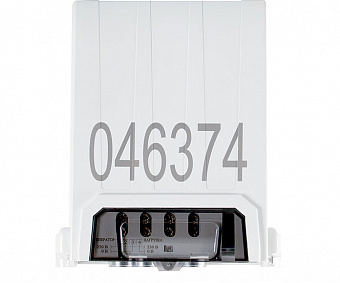
Mercury 208 ART

Mercury 206
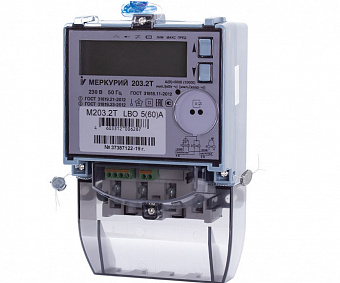
Mercury 203.2T
Table of commercially available meters modifications. Other modifications are available on request.
| Modification | Nominal/ maximum current, А | Interfaces, relay |
|---|---|---|
| Mercury 204 ARTM(2)-01 (D)POBR | 5(60) | optical port, RS485, relay |
| Mercury 204 ARTM(2)-02 (D)POBR | 5(100) | optical port, RS485, relay |
| Mercury 204 ARTM(2)-02 (D)POBHR | 5(100) | optical port, RS485, relay |
| Mercury 204 ARTM(2)-01 (D)POB.L2 | 5(60) | optical port, PLСII, relay |
| Mercury 204 ARTM(2)-09 (D)POB.L2 | 10(100) | optical port, PLСII, relay |
| Mercury 204 ARTM(2)-09 (D)POBH.L2 | 10(100) | optical port, PLСII, relay |
| Mercury 204 ARTM(2)-09 (D)POB.L4 | 10(100) | optical port, PRIME, relay |
| Mercury 204 ARTM(2)-09 (D)POBH.L4 | 10(100) | optical port, PRIME, relay |
| Mercury 204 ARTM(2)-02 (D)POB.G | 5(100) | optical port, GSM, relay |
| Mercury 204 ARTM(2)-02 (D)POBH.G | 5(100) | optical port, GSM, relay |
| Mercury 204 ARTM(2)-02 (D)POBR.G | 5(100) | optical port, RS485, GSM, relay |
| Mercury 204 ARTM(2)-02 (D)POBHR.G | 5(100) | optical port, RS485, GSM, relay |
| Mercury 204 ARTM(2)-02 (D)POB.G5 | 5(100) | optical port, NB-IoT, relay |
| Mercury 204 ARTM(2)-02 (D)POBH.G5 | 5(100) | optical port, NB-IoT, relay |
| Mercury 204 ARTM(2)-02 (D)POBR.G5 | 5(100) | optical port, RS485, NB-IoT, relay |
| Mercury 204 ARTM(2)-02 (D)POBHR.G5 | 5(100) | optical port, RS485, NB-IoT, relay |
| Mercury 204 ARTM(2)-02 (D)POBR.G5 | 5(100) | optical port, RS485, NB-IoT, relay |
| Mercury 204 ARTM(2)-02 (D)POBH.F04 | 5(100) | optical port, LoRaWAN |
| Mercury 204 ARTM(2)-02 (D)POBHR.F04 | 5(100) | optical port, RS485, LoRaWAN |
| Mercury 204 ARTM(2)-02 (D)POB.F04 | 5(100) | optical port, LoRaWAN |
| Mercury 204 ARTM(2)-02 (D)POBR.F04 | 5(100) | optical port, RS485, LoRaWAN |
Meter modification code structure:
Mercury 234 ARTM2 – 0X DPOKxB RLxGxEFxC.RLxGxEFxC
А – active energy measurement,
R – reactive energy measurement,
T – tariffs (TOU) , electronic seals,
2 – bidirectional measurement,
0Х – code of rated/peak current and voltage, accuracy class,
Rated/peak currents, voltages and accuracy classes
| Code | Rated (peak) current, A | Rated voltage, V | Code Accuracy class |
| 01 | 5/60 | 3 x 230/400 | 1/2 |
| 02 | 5/100 | 3 x 230/400 | 1/2 |
| 08 | 5/80 | 3 x 230/400 | 1/2 |
| 09 | 10/100 | 3 x 230/400 | 1/2 |
D – protocol available DLMS/COSEM, SPODES*,
P – extended program functions,
O – built-in load control relay,
Kx – multifunctional inputs/outputs,
B – backlight LCD,
H – measuring element in neutral circuit,
Type of built-in interface (RLxFxC)
Type of plug-in module (RLxGxFxC)
R – RS-485,
Lx –PLC (L2-PLC-II, L4-PRIME PLC, L5-G3-PLC, and other),
Gx – GSM modem (G – CSD/GSM/GPRS, G1 – GSM/GPRS, G3 – UMTS/3G, G4 – LTE/4G, G5 – NBIOT, and other),
Fx – RF modem (F03 – ZigBee, F04 – LoRaWAN Lartech, F05 – ISM868, F06 – Aura360, F07 – LoRaWAN Vega, F08 – Kometa, and other),
C – CAN interface.
* — SPODES - PJSC Rosseti companion specification of DLMS/COSEM protocol.
Have questions?
Please fill in the form. We will filter products for you and give a detailed description.
